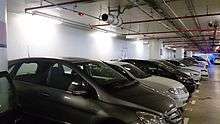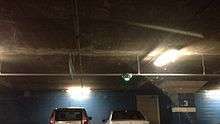Parking guidance and information
Parking guidance and information (PGI) systems, or car park guidance systems, present drivers with dynamic information on parking within controlled areas. The systems combine traffic monitoring, communication, processing and variable message sign technologies to provide the service.
Modern parking lots utilize a variety of technologies to help motorists find unoccupied parking spaces, car location when returning to the vehicle and improve their experience. This includes adaptive lighting sensors and parking space led indicators (red for occupied, green for available and blue is reserved for the disabled; above every parking space), and indoor positioning system (IPS).
PGI systems are a product of the worldwide initiative for the development of intelligent transportation system in urban areas. PGI systems can assist in the development of safe, efficient and environmentally friendly transportation network.[1]
PGI systems are designed to aid in the search for vacant parking spaces by directing drivers to car parks where occupancy levels are low. The objective is to reduce search time, which in turn reduces congestion on the surrounding roads for other traffic with related benefits to air pollution with the ultimate aim of enhancement of the urban area.
Parking Guidance System (PGS)

A Parking Guidance System (PGS) have different elements:[2]
- Detectors
- LED indicators
- Zone Controllers
- Data / Intermediate Controllers
- Central Control System
- Signs
Detectors

Detectors can use different technologies, such as:
- Ultrasonic detectors
- Forward mounting sensors.
- Camera based detectors.[3]
- Infrared based detectors.
- Magnetic sensors that detect vehicles via changes in earth's magnetic field.
- Some use combinations of above technologies to detect vehicles.
LED Indicators
LED indicators. Some manufacturers use LED indicators per space, while others either don't provide any or use one LED indicator for few spaces. The purpose of an LED indicator is to provide guidance to parkers up to the last empty space.
Zone Controllers
The Zone control unit (ZCU) (aka Node Controller), is the middle layer of parking ultrasonic detector, which is to manage a group of ultrasonic detectors, detects then loops the information of the detectors and send the relevant information to a higher element or directly to central controller. One zone / node controller can support between 16 and 100 detectors depending on the manufacturer of Parking Guidance System.
Data / Intermediate Controllers
Some manufacturers use a kind of intermediate controllers, to accumulate data and then channel it to the Central Control Unit and others connect their Zone Controllers to connect directly to the Central Control Unit.
Central Control System
Parking Guidance System management software, an electronic map of the parking space is embedded in the software, which can directly reflect the usage situation of the carpark in real time. The operators can monitor the carpark situation according to the electronic map. As for the wrongly parked vehicles, the system supports manual rewriting its parking spaces to adjust the real occupied situation of the parking space. Database supporting is usually SQL Server/Access.
Signs
- Indoor and outdoor LED displays are used to inform drivers of the available parking spaces and guide them to empty ones.
Patents
See also
References
- ↑ "Traffic Advisory Leaflet ITS 4/03". Parking Guidance and Information. Archived from the original on 6 February 2007. Retrieved 13 April 2007.
- ↑ Idris, M.Y.I.; Leng, Y.Y.; Tamil, E.M.; Noor, N.M.; Razak, Z. (1 February 2009). "Car Park System: A Review of Smart Parking System and its Technology". Information Technology Journal. 8 (2): 101–113. doi:10.3923/itj.2009.101.113. Retrieved 24 September 2015.
- ↑ Hammoudi, K.; Benhabiles, H.; Jandial, A.; Dornaika, F.; Mouzna, J. (1 August 2016). "Developing a Vision-based Adaptive Parking Space Management System". International Journal of Sensors, Wireless Communications and Control. 6: 101–113. Retrieved 5 August 2016.